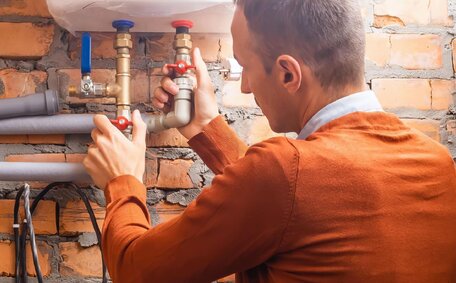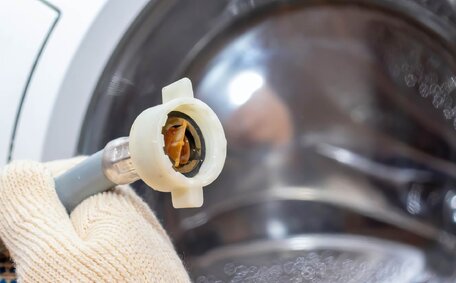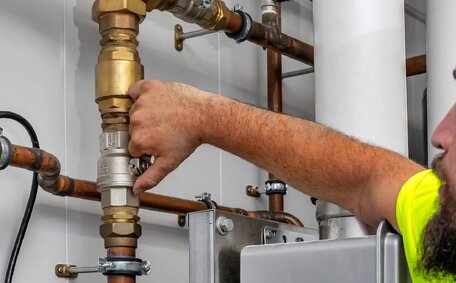Introduction: Ensuring Pet Safety During Plumbing Emergencies
For pet owners, key plumbing measures are crucial to safeguard your pets in emergencies like burst pipes or leaky faucets. Implementing these strategies can prevent harm and ensure your pets’ security.
Standard household features, such as toilets and heaters, can become hazardous for pets during plumbing emergencies.
Consider if open drains or hot water pipes pose burn or fall risks for your pets; high water pressure or standing water can also be harmful.
Plumbing failures may disrupt pet food and water supplies and cause water damage to your possessions and house, underscoring the importance of advance planning.
This guide provides actionable preparation and response tips to prevent pets from getting into trouble. From recognising signs of plumbing issues, emergency planning for your animals, and pet-proofing your home - we’ll cover proactive ways, and much more, to safeguard your furry friends so you can handle the emergency stress-free. Read on to learn how to keep your pets safe throughout the day night cycle!
Identifying Plumbing Risks for Pets
As a pet owner, being vigilant about potential plumbing hazards can help keep your furry friends safe. Here are some key things to look out for:
Leaks
Dripping taps or leaky pipes may seem harmless, but can cause water to accumulate, leading to slippery surfaces that pets could injure themselves on. Catch leaks early before flooding becomes too deep and a major issue occurs.
Exposed Pipes
Pets like nibbling, so exposed water pipes or wiring under sinks place curious cats and dogs at risk of electrocution or burns from chewing. To prevent this, insulate metal pipes and use cord covers.
Open Drains
Uncovered drains, grates, or sending litter down your toilet with an open lid allow small pets to fall in and get trapped or drowned - so installing drain stoppers helps avoid accidents in your yard and indoors.
Burns
Pets can scald themselves on water that’s too hot from unattended taps, malfunctioning water heater units, or burst pipes. Letting water run to test temperature during bath time prevents this.
Stay alert to any gurgling sinks, moist walls, musty smells or temperature changes indicating plumbing issues. Being proactive keeps your home safe!
Preventing Pets from Accessing Hazardous Leaks or Pipes
When dealing with broken pipes or leaks during a plumbing emergency, it’s crucial to act fast to prevent pets from making contact and getting injured. Here are some useful tips:
Use Barriers
Block off access to rooms with hazardous leaks using baby gates or temporary fences. This stops curious pets from approaching and gives you the ability to protect your space while addressing the issue.
Turn Off Main Water Supply
If you can’t immediately halt burst pipes or severe leaks, shut off the water at your property’s main valve. This halts the flow from the compromised water line and limits flooding risks for pets while you arrange repairs.
Wrap Exposed Pipes
For cracked pipes or fittings, use insulation tape to cover the damage temporarily, shielding pet paws from sharp edges and leaks until repairs are done.
Clear Space Around Hazards
Do your best to remove rugs, furniture, and electricals from leak zones in case of water contact and slip hazards. Tidy clutter limiting access and keep walkways clear in case pets approach despite precautions.
Keeping alert and isolating hazards proactively ensures pet safety. Act fast if leaks or pipe damage do occur before injury results.
Securing Pets Before Plumbers Arrive for Repairs
In a plumbing emergency, immediately secure your pets away from the affected area before tradespeople arrive.
Designate a Safe Space
Select an area away from the affected plumbing for your pet with sufficient food and water, toys, litter trays, and bedding. Barrier doors with baby gates, confine smaller pets to carriers, or consider taking them on walks or ensuring they are entertained with cell phones or other devices during the repairs.
Communicate with the Plumber
When booking your plumbing appointment, mention you have pets that will need securing. Discuss access points and working arrangements so professionals enter safely and minimise disruption.
Prepare Essentials Nearby
Keep extra bowls, waste bags, leashes, and carriers close to the pet zone for easy access. This avoids emergency supply runs while managing animals.
Planning ahead keeps pets safely supervised and at ease while urgent plumbing jobs wrap up. Communicate plans clearly with your plumber too for everyone’s comfort.
Maintaining Sanitation to Protect Pet Health
To protect your pets’ health, maintain sanitation during and after plumbing emergencies, as flooding and leaks can spread harmful germs. Regular cleaning and waste disposal are essential.
Disinfect Affected Areas
Disinfect any areas or objects contaminated by sewage or toilet water to prevent bacteria spread. This removes germs and prevents bacterial spread if licked or touched.
Clean Food/Water Bowls
If your water supply is interrupted, use bottled water and wash your pet’s bowls daily to maintain hydration. Dry them completely before refilling to limit bacteria transfer.
Remove Pet Waste
Promptly dispose of pet waste and avoid flushing litter which can contain parasites like Giardia or Salmonella that spread during floods.
Staying on top of cleanliness keeps pets safe when plumbing issues occur. Monitor animals for illness signs and call your vet if concerned after an emergency.
Emergency Preparedness for Pets
It’s vital to have an action plan in place to protect your pets during plumbing emergencies. Prepare an emergency kit with essentials like:
Pet First Aid Supplies
Pack gauze, bandages, antibiotic ointment, scissors, and towels to treat any injuries from leaks.
72-Hour Food/Water
Bottled water, canned food, medications and fillable bowls allow for independent care if water/power is disrupted.
Proof of Ownership
Include registration papers, microchip details and a current photo of your pet in case you need to board them temporarily during repairs.
Designate an emergency shelter, such as a boarding facility or a friend’s home, in case home damage requires evacuation. Confirm shelters will accommodate pets of all types such as reptiles, birds etc.
Ensure you have carriers, leashes, ID tags, and collapsible bowls ready to transport pets. Practising emergency drills makes the plan second nature if disasters ever strike.
Creating a Dedicated Pet Emergency Kit
Having a dedicated emergency kit on hand is vital to keep pets safe when plumbing disasters occur. Include these essential items:
Your kit should contain gauze, tape, antibiotic ointment, scissors, cotton balls, and towels to handle pet injuries such as cuts or burns from plumbing mishaps.
3 Days’ Worth of Food & Water
Include a 3-day supply of bottled water, food, medications, and fillable bowls to maintain your pet’s hydration and nourishment.
Store copies of registration papers, vet records, microchip details, current photos, and medication lists. This aids pet recovery or temporary boarding if you must evacuate for repairs.
Transport Supplies
Include sturdy leashes, harnesses, carriers, blankets, collapsible food bowls, potty pads, waste bags and litter trays. These let you take pets with you or confine them safely during jobs.
Identification
Ensure pets wear secure collars with ID tags listing your contact details. Include a backup tag inside the kit too. This aids emergency reunification if pets escape hazard zones.
Store the kit in a reachable, dry area and refresh supplies biannually to keep household plumbing safe for pets, readying you to protect them in any emergency.
Having an Evacuation Plan Tailored for Pets
If major plumbing issues render a property uninhabitable, it’s crucial to have an evacuation plan specifically for pets. Key tips include:
Identify Pet-Friendly Accommodation
Find hotels or boarding venues that accommodate pets, including birds and reptiles, or consider friends and family for emergency housing. Exchange your vet’s details as well.
Prepare Transport
Ensure carriers or restraints are sized correctly for pets and practise car travel to reduce stress. Pack leashes, cages, blankets and motion sickness medication if required.
Communicate Special Needs
Note details like health issues, medications, dietary needs or mobility restrictions requiring accommodation, especially for pets that may normally work outside. Share documentation proving ownership too.
Pack Familiar Items
Include favourite toys, treats, beds and worn unwashed clothing with comforting scents. This aids relaxation for pets who maybe outside during an evacuation to unfamiliar areas.
Run through mock emergency drills using your tailored pet plan yearly. By practising what you can do ahead of emergencies, you minimise chaos if real plumbing issues strike, keeping your animals safe.
When Professional Help is Needed
Seeking help from your local plumbing professionals often makes a significant difference when issues threaten to put pets at risk. Seek out a licenced, experienced plumber like Saint Marys Plumbing for prompt support when:
- There are large leaks, bursts or pipe damages beyond DIY abilities to mend
- Sewage lines back up or toilets overflow, contaminating floors
- No water flows from taps, preventing hydration/sanitation for pets
- Gas appliances malfunction, causing leak or explosion risk
- Electrical shorts occur near water sources pets could access
Our team offers 24/7 plumbing repairs to quickly restore safety and functioning when disastrous faults emerge. With specialised equipment, extensive training and emergency responsiveness, we’ll handle jobs securely without endangering pets.
Don’t delay - call 1300 349 338 if complex, hazardous plumbing issues occur. Protecting your home and furry friends is our top priority.
Informing Plumbers About Pets on the Premises
Advise plumbers about pets on your property when scheduling repairs to allow for proper safety precautions for your animals.
Provide Details Upfront
When arranging your plumbing appointment, mention you have pets at the property and their type/size. Highlight sensitive animals requiring special care like birds.
Confirm Access Routes
Discuss entry points to your home and whether pets have access to these areas. Advise which rooms to avoid and suggest the best areas to isolate them.
Ask About Chemicals
Enquire if plumbers use any cleaning solutions or chemicals potentially hazardous if licked or touched by curious pets. Request non-toxic products if possible.
Open communication allows professionals to set up safely around your furry friends and prevents escaped pets wandering into harm’s way.
Common Plumbing Issues and Pet Hazards
As a pet owner, being aware of common plumbing hazards inside your household can help you safeguard your furry friends. Here are some key risks to watch for:
Blocked Drains
Blocked sinks or sewer lines can collect bacteria-laden water. Regularly trim pets’ fur to prevent it from clogging drains and creating standing water hazards.
Leaky Pipes
Burst pipes or leaks around appliances can actually lead to slippery floors and pooling water. Pets could injure themselves or receive electric shocks. Insulate pipes and monitor fittings, which can prevent potential pet injuries.
Faulty Toilets
A cracked toilet tank can expose pets to harsh cleaners and bacteria. Keep toilet lids shut and fix leaks quickly to maintain a pet-friendly plumbing environment.
Hot Water Burns
Set heaters to safe temperatures and insulate exposed pipes to prevent burns from unattended taps or burst pipes should pets escape.
Be vigilant in identifying plumbing issues. Take preventative measures to avoid pet contact with water hazards until they are fixed.
Conclusion: Keeping Pets Safe During Plumbing Disasters
In summary, pet owners have an important responsibility to safeguard their furry friends during plumbing emergencies. By being vigilant to identify risks, proactively addressing hazards, preparing emergency plans, and securing professional assistance promptly, you can keep companions out of harm’s way.
Remember to isolate pets from leaks, wrap and insulate damaged pipes, and disinfect contamination. Maintain clean drinking water, create dedicated emergency kits, and know evacuation protocols. Communicate pet needs clearly to tradespeople too.
Stay informed and act swiftly to shield your pets. For immediate plumbing repairs and advice, contact Saint Marys Plumbing at 1300 349 338.
Our pet-conscious plumbing service ensures your family remains safe and sound. Contact us anytime at our 24/7 consultation line for information and assistance.






